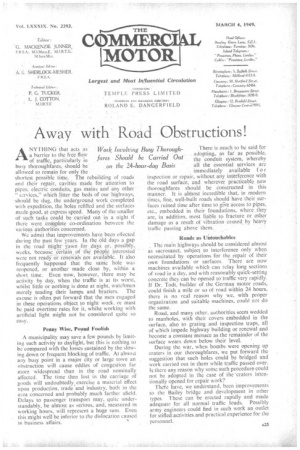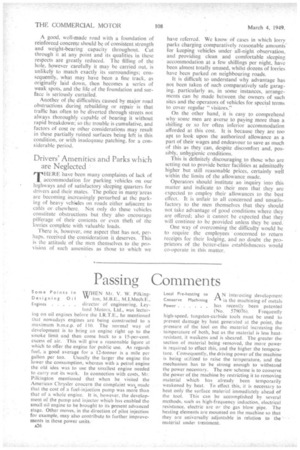Away.. with Obstructions!
Page 1

Page 2

If you've noticed an error in this article please click here to report it so we can fix it.
ANYTHING that acts as a barrier to the free flow of traffic, partieularly in. busy thoroughfares,, should be allowed to remain for only the short* possible time The rebuilding of roads and their repair, cavities made for attention to pipes, electric Conduits, gas mains and any other " "services," which litter the beds of our highways, • should be -dug, the underground work completed with expedition, the holes refilled and the surfaces made good, at express speed. Many of the smaller of such tasks could be carried out in a night if there were complete Co-ordination between the various authorities concerned. .
We admit that improvements have been effected. during the past few years. In the old. days a gap in the road 'Might , yawn for days or,. possibly,, weeks, because Certain of , the People interested. " were not ready or rcne‘Vals not available. It also frequently happened that the nine hole was reopened, or another made close by, within a short time. Even now, however, there may be activity by day, when the traffic is at its worst, whilst little or nothing is done at night, watchmen merely tending their lamps and braziers. The excuse is often, put forward that the men engaged in these operations object to night work, or must he paid overtime rates for it, whilst working with artificial light might not be considered quite so easy.
Penny Wise, Pound Foolish A municipality may save a few pounds by limiting such activity to daylight, but this is nothing to be compared with the losses sustained by the slowing down or frequent blocking of traffic. At almost any busy point in a major city or large town an obstruction will cause eddies of congestion far more 'widespread than in the road nominally affected. The time then lost in the carriage of goods will undoubtedly, exercise a material effect upon production, trade and industry, both in the area concerned and probably much farther afield. Delays to passenger transport may, quite understandably, be almost as serious, and, measured in working hours, will represent a huge sum. Even this might well be inferior to.the dislocation caused in business affairs. There is much to be said for adopting, as far. as possible, the conduit sYStem, whereby all the essential services are immediately available f o r inspection or repair, without any interference with the road surface, and wherever practicable new thoroughfares should be constructed in this Manner. It is almost incredible that, in modern times, fine, well-built roads should have their surfaces ruined time after time to gilt access to pipes, etc., embedded in their foundations, where they are, in addition, most liable to fracture or other damage as a result of vibration caused. by heavy traffic passing above them.
Roads as Untouchables , The main highways should be considered almost as sacrosanct, subject to interference only when necessitated by operations for the repair of their own foundations or surfaces. There are now machines available which can relay long sections of road in a day, and with reasonably quick-setting concrete they can be opened to traffic very rapidly. If Dr. Todt, -builder of the German motor roads, could finish a mile or so of road within 24 hours, there is no real reason why we, with proper organization and suitable machines, could not do the same.
Road, and many other, authorities seem wedded to manholes, with their covers embedded in the surface, also to grating and inspection traps, all of which impede highway building or renewal and become a constant menace as the remainder of the surface wears down below their level.
During the war, when bombs were opening up craters in our thoroughfares, we put forward' the suggestion that such holes could be bridged and work carried out in them while traffic passed over. Is there any reason why sonte such procedure could not be adopted in the case of the -craters intentionally opened for repair work? There have, we understand, been improvements to the Bailey bridge and development in other types These can be erected rapidly and made adequate for all normal traffic loads. Possibly army engineers could find in such work an outlet for stifled-activities and practical experience for the personnel, A good, well-made road with a foundation of reinforced concrete should be of consistent strength and weight-bearing capacity throughout. Cut through it at any point and its qualities in these respects are greatly reduced. The filling of the hole, however carefully it may be carried out, is unlikely to match exactly its surroundings; consequently, what may have been a fine track, as originally laid down, then becomes a series of weak spots, and the life of the foundation and surface is seriously curtailed.
Another of the difficulties caused by major road obstructions during rebuilding or repair is that traffic has often to be diverted through streets not always thoroughly capable of bearing it without rapid breakdown; so the trouble is cumulative, and factors of cost or other considerations may result in these partially ruined surfaces being left in this condition, or with inadequate patching, for a considerable period.


























